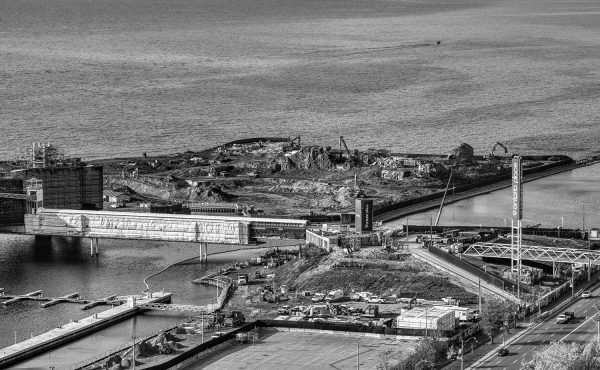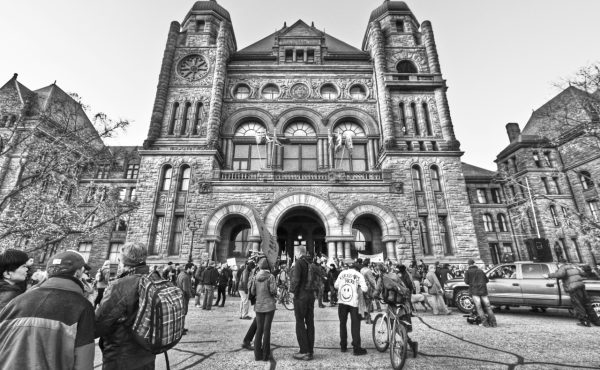
Are we in the midst of a golden age of transit construction in Toronto?
I pose the question in complete seriousness to all the grim-faced fans of OneCity, which was tearfully (or gleefully) dispatched last week, apparently the latest in the grim list of Toronto’s still-born transit schemes.
I prefer to take the long view, and I’d argue that council’s level-headed decision about the Stintz/DeBaeremaeker 30-year-plan must be understood in not just a wider historical context, but also mindful of the sheer complexity — financial, technical, and political — that colours the city’s current deliberations over transit.
So before we go any further, it’s worth munching on the following timeline and the four clear phases of rapid transit development in Toronto (and the GTA):
The Golden Age of Subways and Commuter Rail: 1949-1968 (19 years)
Construction of Yonge-University and Bloor-Danforth lines; GO established
The Era of Continuous Expansion: 1973-1985 (12 years)
Extension of Yonge to Finch; Spadina line from St. George to Wilson; Bloor-Danforth to Kennedy and Kipling; Construction of the Scarborough RT; Expansion of GO train service to Georgetown and Richmond Hill
The Lost Decade: 1990-2002 (12 years)
Spadina extended from Wilson to Downsview; construction of Spadina & Harbourfront streetcar lines; GO service reduced; Eglinton subway cancelled; Sheppard subway opens.
The Current Era: 2004-2020 (16 years)
TTC Ridership growth strategy adopted; Construction of St. Clair right-of-way; Viva begins operation; Metrolinx established; Transit City approved; Big Move approved; GO Lakeshore, Georgetown and Milton corridor expansions; Union Station modernization; Mississauga and VIVA BRT corridor construction; Spadina subway extension to Vaughan; Toronto LRTs (Crosstown, Finch, Sheppard, Scarborough RT conversion) approved and re-approved; Air-Rail Link.
The history, in short, speaks for itself, and loudly. None of this is to suggest that all these projects will necessarily be successful, nor that the next chapter is a foregone conclusion, because it is not.
Council’s decision to ask staff to bundle a detailed report on funding options with a long-term route development strategy, plus prioritization recommendations, plus the requisite changes to the official plan, means the deciders will finally have most of the information they need to make informed decisions about how to proceed. That alignment of policy advice is, amazingly enough, unprecedented.
Yes, the Stintz/DeBaeremaeker plan torqued public expectations and then inflicted what may have seemed, to many residents and pundits, like yet another Toronto let-down. I have no special insight into whether the councillors involved had an endgame in mind, but they surely knew that city council wasn’t going to make a decision in three months. Yet they opted to go for a Hail Mary pass because it was the right moment to take a few political risks.
Perhaps the epitaph on the OneCity headstone is that it raised the stakes.
The council debate in October won’t, I’m guessing, be satisfyingly definitive either; rather, I expect it could serve as a crucial stage in the broader fork-in-the-road decision-making process that will play out over the balance of 2012 and 2013.
Soon after Labour Day, various pressure groups and Metrolinx itself will step up public discussion about the long-term funding strategy to build The Big Move. Amidst all that attention, council will be called on to express a collective position on what kind of revenue tools should be used to fund future transit expansion; whether these should be sequestered in a dedicated transit fund; which ones can be imposed unilaterally and which need to be levied regionally; and, lastly, whether to make the leap and vote to approve a special levy to finance the East Bayfront LRT. All good.
As for the long-term plan itself, as Karen Stintz noted several times, most of the routes in OneCity were part of the Big Move map, except the Bayfront LRT, the subway extensions up to Scarborough Town Centre and along Sheppard West, and the conversion of the Air-Rail Link to express rail service with more local stops.
City officials have been asked to come up with a new map that only includes previously approved plans, broadly defined, and their recommended priorities. The DRL will be at the top of the list. I wouldn’t expect substantial shifts away from other elements of the Big Move plan. The two new OneCity subway lines are mostly about politics. Consequently, the outcome depends entirely on whether the imprimatur of a staff report, plus whatever backroom negotiating takes place on the barbeque circuit over the summer, prompts Metrolinx and the Liberal cabinet to reconsider.
Whether or not all this will be resolved at the October council meeting is, to some extent, moot; the most important detail is that the politicians and the bureaucrats are finally seized with the matter of what happens after Crosstown is complete, circa 2020, and how the next tranche of transit projects will be financed.
Indeed, what must happen, at some point over the next six months or so, is that Toronto council clearly articulate to Metrolinx and the province what City of Toronto residents are willing to contribute to agency’s long-awaited investment strategy to raise $50-billion-plus over 25 years to pay for GTA-wide transit expansion, including many of the colourful lines on the OneCity maps.
Moreover, council should send an unambiguous political message to Metrolinx and the province that the DRL must be the next big project approved for the GTA. Indeed, council could raise the stakes by ordering staff to begin the lengthy technical and public planning process for that line, so the DRL is ready to roll as soon as the political decisions over funding have been made. After all, Markham is deep into a detailed conceptual planning process [ PDF ] for the Yonge extension up to Richmond Hill; there’s no reason Toronto shouldn’t be doing the same thing.
Coming back to the history, I’d say this moment reminds me of 1985, when Metro released Network 2011, an ambitious long-term vision remarkably similar to OneCity, but launched at a time when the province covered 80% of the TTC’s capital costs and half of the operating subsidy.
In that instance, Metro and the province dithered for a few years — long enough to watch the real estate market collapse in 1989 as the economy plunged into a brutal recession that appeared to render transit expansion unnecessary. By the early 1990s, Queen’s Park had a mighty deficit and the moment had passed.
As Marx observed, history repeats itself first as tragedy, second as farce.





6 comments
But, really the only new transit in Toronto since 2004 is the St. Clair ROW. And that’s not even that ‘new’ since the line was there. The only thing we can reasonable count on is the YorkU extension, and maybe the Eglinton line. I don’t think anyone will believe until they ride it.
I like your articles, John, and I’m trying to see your point, but look at how many boards have been set up, plans made, and maps drawn. And nothing gets built. I think we’re at this weird point now where another plan or map would only add to the farce and further disillusion transit riders. Especially since the majority of the ‘transit debate’ is about money and making way for cars – not about transit users needs or experiences.
“struck a Map of the Empire whose size was that of the Empire” – Borges
@Mark. “Nothing gets built.” Go to Eglinton just east of Black Creek Drive and look at the hole. The Crosstown is being built. Metrolinx is also proceeding with the tendering of the Finch and Sheppard lines, and engineering specs for the Scarborough RT replacement.
John Lorinc wrote, “After all, Markham is deep into a detailed conceptual planning process for the Yonge extension up to Richmond Hill..”That should read “York Region” not “Markham”.
Yes, John, but there was once a hole dug on Eglinton. I realize that it’s very likely that this time the line will be built, but I think many people have become disillusioned – especially when they hear of more tenders, engineering specs, maps and plans. I realize these things are needed to get something built, but it’s increasingly becoming all we ever hear. We get these plans and maps, people debate them then they don’t come to fruition.
I think he means the new hole. THERE’S A NEW HOLE BEING DUG IN TORONTO!
We don’t need a plan with a fancy name which stands alone and can be torn down at a whim. We need transportation to be fully integrated into the Official Plan, gradually evolving as forecasted demand becomes better understood as time horizons shift. It has to be more than a chew toy for changing regimes and management biases – the current crazy shifts in outlooks from surface to subway and back are a huge disincentive to getting the public to buy into long term funding strategies. At present the TTC handles service planning and service delivery and maybe it’s time those functions had some firewalling between them if not separated entirely.